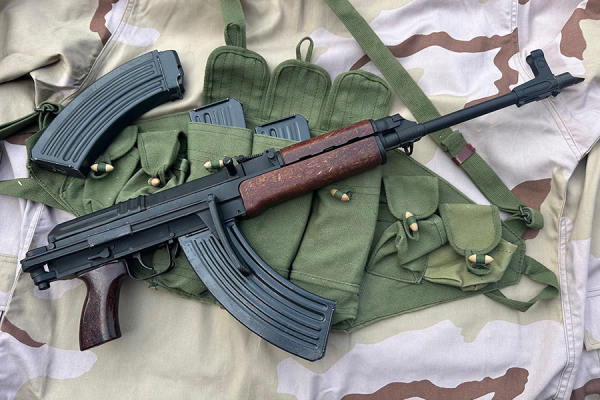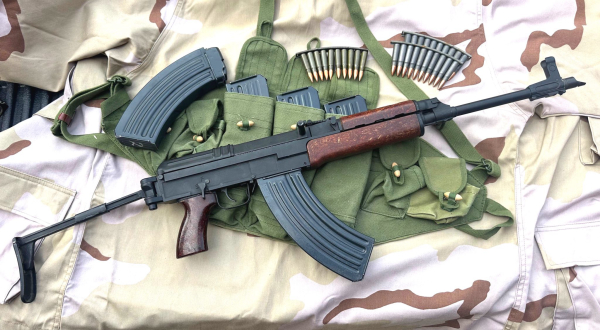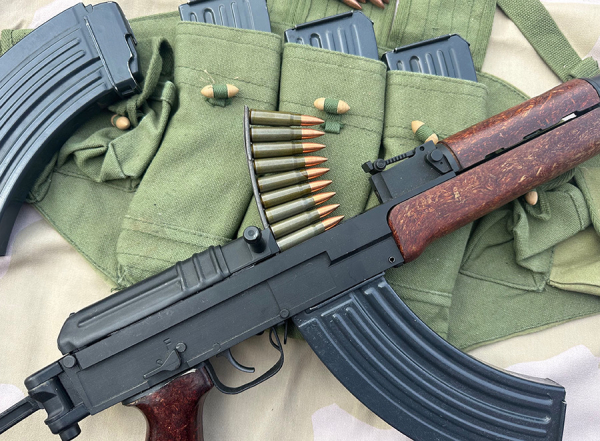
If you really want to start a fight with a gun culture person, refer to the VZ-58 as the “Czech AK”. To many purists, those are fighting words. As we progress in our consideration of guns of the Cold War, the VZ-58, Czechoslovakia’s answer to the AKM, deserves to be considered on its own.
Not Everyone Wanted Russian Guns
Much ink has been used discussing the Russian tendency to license and loan the plans for firearms designed in Mother Russia to their various allies. The Communist Chinese, being imitative more so than innovative, were more than happy to simply cut and paste the plans for the SKS, the AKM, and numerous others.
Many of the Warsaw Pact countries, of which Czechoslovakia was, viewed the license to produce tested and approved firearms as a tremendous savings in time and money. There was no need to spend years and millions to build a gun from the ground up when you could just copy one that worked.

However, Czechoslovakia was not one of these. Yes, before you correct me by yelling “Czech Republic”, that is not what the country was called during the Cold War or when the VZ-58 was designed and produced. Having bought into the communist/socialist way of thinking, Czechoslovakia was a “Marxist/Leninist State” during the Cold War. Despite that fact, their relationship with Russia was not all wine and roses. Regardless of the relationship between the two socialist nations, as far as NATO was concerned, Czechoslovakia was a Soviet “satellite-state”, and one of the bad guys.
The Czechs were/are a proud people and this was demonstrated in their desire to not adopt the AKM, but to design their own battle rifle. The use of the 7.62x39mm cartridge, however, simply made good practical and economic sense since it was the main rifle round for the Warsaw Pact countries.
VZ-58
The VZ-58 project began in 1956 and the chief engineer was Jiří Čermák. Despite the “58” in the name, the rifle was officially accepted and began production in 1959. The basic thought process was similar to the one that went into the AK-47 design; produce a lighter, more compact, magazine-fed battle rifle as a replacement for the large, heavy and low-capacity rifles that were used during WWII and immediately after.

As mentioned, the decision was made to build the gun around the M43 cartridge. With the USSR producing ammunition in the billions, that only made sense. The standard “box” magazine for the VZ-58, made of ribbed aluminum alloy, held 30 rounds of the famous cartridge. No, the VZ-58 magazine is not the same as an AKM magazine, despite sharing the unique “banana” curve. They are NOT interchangeable.
Unlike the AKM receiver which is stamped and folded sheet metal, the receiver on the VZ-58 is machined steel. Internally, the action is gas piston-driven and the operating mechanism along with the recoil spring assembly actually look more like the SKS than the AKM. There is a steel dust cover at the rear and the ejection port area is wide open, I mean all the way open.
The VZ-58 was designed with an empty magazine hold open and if the end user desired, rather than switch magazines, they could use 10 round stripper clips of M43 and top load the gun. There is a stripper clip guide built into the bolt, a la the SKS.
However, the aforementioned method would appear to be one of those ideas that seemed great on paper but didn’t play out so well in the real world. I can tell you from experience that, while it is possible to reload your VZ-58 in such a manner, the strength, dexterity and time needed for such an endeavor is completely impractical on the battlefield or in simple range practice.
I suppose if you were only issued one magazine and a bunch of ammo on stripper clips you might muscle through and make do, but that method is less than ideal. It puts me in mind of the feature on the M249 SAW where you could ostensibly use a 30 round STANAG magazine to feed the gun if you ran out of belted ammo. When I was in the Marine Corps infantry, I never encountered a SAW that would feed reliably with an aluminum 30 round mag. Perhaps a brand new SAW with brand new mags might do so, but that wasn’t practical reality.
Even though you might mistake a VZ-58 for an AKM from a distance, there are other features that make it stand out. The VZ-58 “P” was the fixed stock version. The shoulder stock, pistol grip, and forend were made from a composite material colloquially referred to as as “beaver-barf.” Rather than carve stocks out of hardwood, the Czechs chose the money-saving method of blending wood pulp and shavings with resin.
In addition to arguing about the 58 being called the “Czech AK,” there’s also contention about the stock material. Some sources say that bakelite was used in the process, while some sources describe it as a resin or polymer blend. I have it on good authority from a Soviet-era firearms expert that bakelite was used in the VZ-58 stocks. That’s good enough for me. For those who are curious . . .
“Bakelite (/ˈbeɪkəlaɪt/ BAY-kə-lyte), formally polyoxybenzylmethylenglycolanhydride, is a thermosetting phenol formaldehyde resin, formed from a condensation reaction of phenol with formaldehyde.”
However you slice it, the beaver barf color (and texture) of the furniture is one of the standout features of the VZ-58.

The Czechs wanted a select-fire battle rifle, and the selector lever is located on the right side of the receiver. This was a big departure from the Kalashnikov safety-lever/dust cover design. On the VZ-58, when the selector is pointed down, it’s on safe. Pushed forward, it’s on auto and pulled rearward it’s semi. Other controls include the charging handle which is on the right side attached to the bolt and the magazine release lever found on the left side of in front of the triggerguard. The mag release lever is slightly recessed into the triggerguard area to prevent unintentional activation.
As for the adjustable iron sights, they’re not exact copies of the AKM, but they’re very similar. The front sight can be BZO’d for elevation and windage (with a sight tool) and the rear sight has 100 meter settings out to 800 meters, which seems rather optimistic.
The steel barrel was originally 15.4 inches. Semi-auto imports of the gun, such as the VZ-2008 Sporter, have a 16-inch barrel for compliance reasons. Also, the American-legal imports use the AKM “slant brake.” Again, though not exactly the same, the barrel/gas piston system on the VZ-58 is similar to that of the AKM with the barrel underneath the gas piston action.

Additionally, just as the AKM had to be made in a “paratrooper” or “airborne” configuration with folding stocks, the VZ-58 “V” model had a side-folding steel stock for motorized or airborne troops. The two basic versions of the rifle are the fixed stock “P” and the folding “V”.
The finished product proved to be lightweight and compact, especially when compared to the long, heavy WWII rifles. The VZ-58 “P” was 33.3 inches long as was the “V” with the stock extended. With the stock folded, the “V” was 25 inches. The empty weight of the gun was only 6.4 pounds.
By comparison, the VZ-24 rifle — the WWII staple for the Czech homeland — was 9.2 pounds, 43.3 inches long and held five rounds. The VZ-52 that bridged the gap between WWII and the VZ-58, was 9.13 pounds, 39.6 inches long and used a 10-round detachable box magazine.
Imagine being an infantry soldier and receiving a fighting rifle that held three times the ammunition and was three pounds lighter. Plus it had a giggle switch to shoot like a machinegun.

More than just an interesting idea, nearly one million of these guns were made in the Czechoslovak Socialist Republic. As a gun of the Cold War, the VZ-58 was used in proxy wars in Vietnam, Laos and Cambodia, as well as on the continent of Africa and in the Middle East. Most recently, VZ-58s have been captured on the battlefield during the Russo-Ukrainian War. It seems like there’s still a lot of fight left in this old dog.
Parting Shots
There are US legal, semi-automatic, modernized versions of the VZ-58 that can be found at various online gun sellers. They aren’t cheap, but if you want one, they’re unique and enjoyable to shoot. The original design aluminum alloy magazines can be tough to come by, but new polymer versions can be found online.
Specifications:
Caliber: 7.62x39mm
Action: Gas piston/select fire
Capacity: 30 rounds
Furniture: Mixture of pulpwood and resin (others)
Barrel Length: 15.4 inches (others)
Overall Length: 33.3 inches
Weight (empty): 6.4 lbs
— Paul G. Markel, Shooting News Weekly
Paul G. Markel is the founder of Student the Gun University and has been teaching Small Arms & Tactics to military personnel, police officers, and citizens for over three decades. He is the author of numerous books and is a combat decorated United States Marine veteran.